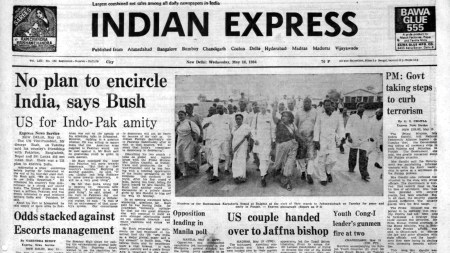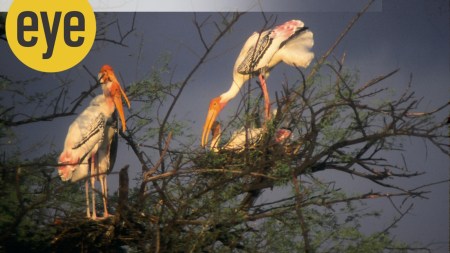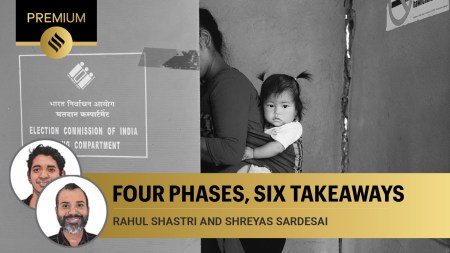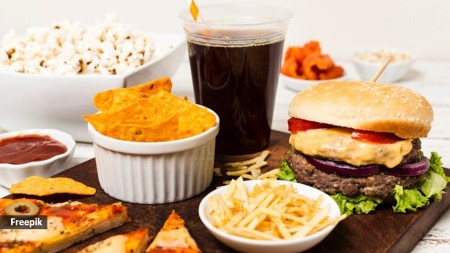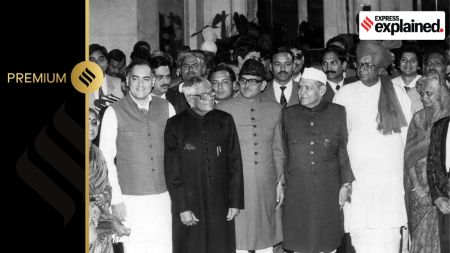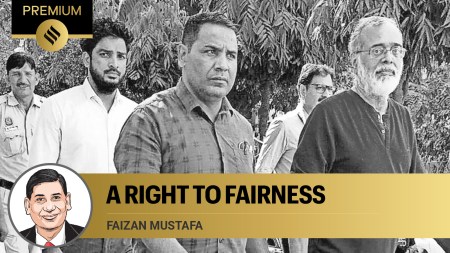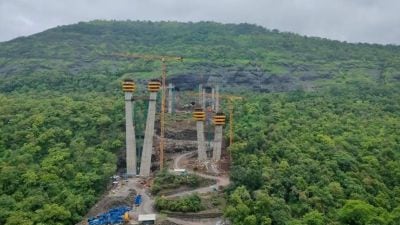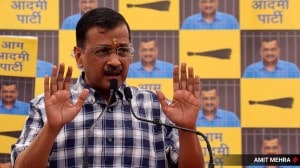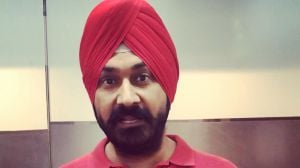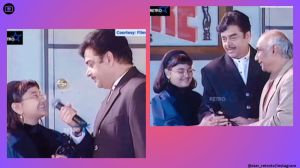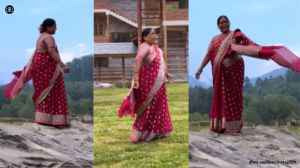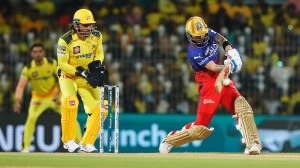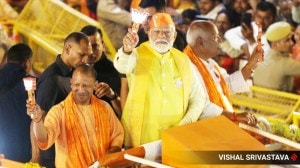- India
- International
UPSC Key | 3rd May, 2024 — Article 361, Diplomatic Visa, Manipur and more
Exclusive for Subscribers from Monday to Friday: How are Article 361 and Diplomatic Visa relevant to the UPSC Exam? What significance do topics like domestic violence and Indian spies have for the preliminary and main exams? You can learn more by reading the Indian Express UPSC Key for May 3, 2024.
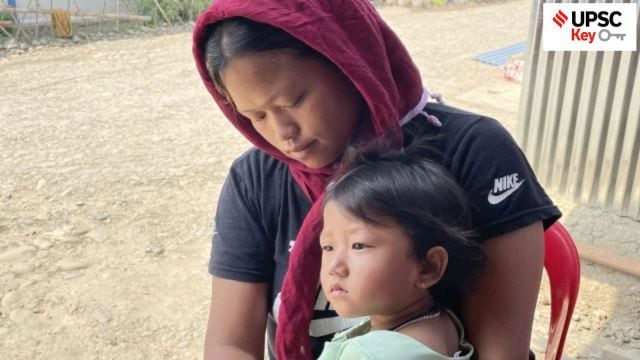 A Kuki woman who meets her children once a month in Mizoram as they live with her Meitei husband in Imphal.
Know more in our UPSC Key. (PTI)
A Kuki woman who meets her children once a month in Mizoram as they live with her Meitei husband in Imphal.
Know more in our UPSC Key. (PTI)Important topics and their relevance in UPSC CSE exam for May 3, 2024. If you missed the May 2nd, 2024 UPSC CSE exam key from the Indian Express, read it here.
🚨 The Indian Express UPSC Essentials brings to you the April edition of its monthly magazine. Click Here to read. Share your views and suggestions in the comment box or at manas.srivastava@indianexpress.com🚨
Front Page
Manipur marks one year of conflict: Counting the cost—amid tears
Syllabus:
Preliminary Examination: Current events of national and international importance
Mains Examination: GS-II, GS-III: Governance, Internal Security
What’s the ongoing story- A call to observe May 3 as ‘Kuki-Zo Awakening Day’, a ‘condolence service’ in Churachandpur, a meeting on ‘365 days of Chin-Kuki Narco Terrorist Aggression’ in Imphal — different groups in Manipur will mark one year of ethnic conflict in the state in different ways Friday, a reminder of just how deep the faultlines still remain.
Prerequisites:
— What are the reasons for insurgency in Manipur?
— Who are Meiteis, Kuki-Zos and Nagas?
— How is the situation in Manipur now?
Key takeaways:
— Patricia Mukhim in the Idea Page writes: “The communities in Manipur — the Meiteis, Kuki-Zos and Nagas — are Tibeto-Burmans, believed to have migrated from the northwestern frontiers of China. They first settled in present-day Myanmar before migrating to what is today Manipur.”

— “This history is, however, contested — the Meiteis claim to be indigenous to Manipur and regard the Kuki-Zos as interlopers. The Nagas of Manipur claim to be indigenous to the state’s hill regions.”
— “Landholding patterns, much of which are a product of colonial rule, add to the state’s complexity — the tribal communities are spread over the hill areas, while the Meteis are concentrated in Imphal Valley.”
— “Political discourse in the state often skims the surface of deep faultlines. It takes the form of a “them versus us” binary with the Meiteis blaming the Kuki-Zos of being illegal migrants and poppy growers, responsible for the drug abuse amongst a large section of Manipur’s youth. The hill tribes accuse successive state governments of forcing them to the margins of development.”
— “The state’s poor economic status adds to people’s anxieties — after UP and Bihar, Manipur has the third lowest per capita income in the country. Urban poverty is the highest in the state. Economic anxieties often manifest in animosity between communities.”
— “Manipur needs a calming hand. It needs a leadership that can bring Meiteis and the Kuki-Zos to the talking table. But a year has passed and there are no visible signs of peace-building.”
For Your Information:
— Historical Background: Ethnic tensions between the hill communities and the Meiteis have existed from the time of the erstwhile kingdom, but the friction started escalating with the advent of the Naga national movement in the 1950s, and the call for an independent Naga nation.
— The Naga insurgency was countered by the rise of insurgent groups among the Meiteis and Kuki-Zomi.
— In the 1990s, as the NSCN-IM pushed harder for self-determination, the Kuki-Zomi groups began to militarise, and the Kukis launched their own movement for ‘Kukiland’ — unlike the Naga movement, however, the Kuki-Zomi demand was for a state within India, not a separate national homeland.
— The Naga and Kuki movements fuelled Meitei nationalism, and numerous groups sprung up in the valley. Concerns over demographic change and the shrinking of traditional Meitei areas started to surface in the 1970s. There were some demands for Scheduled Tribe status for Meiteis, but the discourse remained largely muted.
Points to Ponder:
— What are the steps taken by the government to develop trust between Meitei and Kuki?
— Role of the civil servant in dealing with the humanitarian crisis.
— What are the other ethical issues in north-east India?
— How to counter-insurgency while ensuring development in the region?
Post Read Question:
“The faultlines in Manipur have only deepened since the violence broke.” What immediate steps need to be taken by all the stakeholders to ensure peace and harmony in the region?
Other Important Articles Covering the same topic:
Manipur’s ethnic faultlines: Kuki-Meitei divide & recent unrest
Art 361: Immunity shield until Governor in office
Syllabus:
Preliminary Examination: Indian polity and Governance- Constitution, Rights Issues.
Mains Examination: GS-II: Governance, Constitution, Polity, Constitution of India- features, amendments, significant provisions and basic structure, Appointment to various Constitutional posts, powers, functions and responsibilities of various Constitutional Bodies.
What’s the ongoing story- Even as a complaint alleging sexual harassment has been filed in Kolkata against West Bengal Governor C V Ananda Bose, Constitutional immunity bars the police from naming the Governor as an accused or even investigating the case.
Prerequisites:
— What is Article 361 of Indian Constitution?
— What are the provisions related to the Governor in the Indian Constitution?
— How does the role of the governor differ from that of the President in terms of their constitutional positions?
— Office of Governor-know the historical background
Key takeaways:
— Article 361 of the Constitution that deals with immunity to the President and the Governors states that they “shall not be answerable to any court for the exercise and performance of the powers and duties of his office or for any act done or purporting to be done by him in the exercise and performance of those powers and duties…”
— The provision also has two crucial sub-clauses: (1) that no criminal proceedings whatsoever shall be initiated or continued against the President, or the Governor of a State, in any court during the term of his office. (2) No process for the arrest or imprisonment of the President, or the Governor of a State, shall issue from any court during his term of office.
— In the landmark 2006 ruling in Rameshwar Prasad v Union of India, that outlined the immunity enjoyed by the Governor “even on allegation of personal malafides,” the Supreme Court held that “the position in law, is that the Governor enjoys complete immunity.”
— “Governor is not answerable to any Court for the exercise and performance of the powers and duties of his office or for any act done or purporting to be done by him in the exercise and performance of those powers and duties,” the Court said. The ruling is indeed not for criminal complaints but for exercising discretionary constitutional powers.
Points to Ponder:
— What are the challenges associated with the Governor’s office?
— What constitutional reforms are suggested by various committees and the Supreme Court regarding the office of Governor?
(Thought Process: Administrative Reforms Commission of 1968, the Rajamanar Committee of 1969, the Sarkaria commission of 1988 and Punchhi Commission-What were their recommendations in the context of role of Governor?.)
— What is role of governor in legislative procedure in state legislature?
Post Read Question:
Prelims
Consider the following statements: (2018)
1. No criminal proceedings shall be instituted against the Governor of a State in any court during his term of office.
2. The emoluments and allowances of the Governor of a State shall not be diminished during his term of office.
Which of the statements given above is/are correct?
(a) 1 only
(b) 2 only
(c) Both 1 and 2
(d) Neither 1 nor 2
Mains
Discuss the essential conditions for exercise of the legislative powers by the Governor. Discuss the legality of re-promulgation of ordinances by the Governor without placing them before the Legislature. (2022)
Other Important Articles Covering the same topic:
Explained: Governor’s powers, friction with states, and why this happens often
The 360° UPSC Debate | Does India really need state Governors?
Explained
Prajwal’s flight: How diplomatic passports, visa regimes work
Syllabus:
Preliminary Examination: Current events of national and international importance.
Mains Examination: GS-II: Governance, Constitution, Polity, Social Justice, and International Relations.
What’s the ongoing story- After allegations of sexual abuse by Janata Dal (Secular) MP Prajwal Revanna came to light, the politician fled to Germany on a diplomatic passport. The Ministry of External Affairs (MEA) on Thursday (May 2) said that no visa note was issued to Revanna — but to travel to Germany, he did not need one. Here is why.
Prerequisites:
— What is a diplomatic passport?
— Who issues diplomatic passports and to whom in India?
— What is the Henley Passport Index? What is India’s rank in it?
— Are there other passport indices?
Key takeaways:
— Unlike normal passports, which have dark blue covers and are valid for 10 years (for adults), diplomatic passports have maroon covers, and are valid for five years or less. Holders of such passports are entitled to certain privileges and immunities as per the international law, including immunity from arrest, detention, and certain legal proceedings in the host country.
— The MEA’s Consular, Passport & Visa Division issues diplomatic passports (‘Type D’ passports) to people falling in broadly five categories: those with diplomatic status; government-appointed individuals travelling abroad for official business; officers working under the branches A and B of the Indian Foreign Service (IFS), normally at the rank of Joint Secretary and above; and relatives and immediate family of officers employed in IFS and MEA.
— Diplomatic passports are also issued to “select individuals who are authorized to undertake official travel on behalf of the government”. This includes union ministers and MPs who often travel abroad representing the government. The validity of these passports is concurrent with the term of the MP.
— According to the latest bulletin issued by the Rajya Sabha Secretariat, “Members, when using a diplomatic passport, are required to apply for prior political clearance directly to MEA.
— As per the Passport Act 1967, the passport authority may impound or revoke a passport if the holder is in wrongful possession, or if it was obtained by the suppression of material information; or if the passport authority deems it necessary so to do in the interests of the sovereignty and integrity of India, or friendly relations of India with any foreign country. It can also be revoked if the holder has, after the issue of the passport, been convicted by a court in India….
For Your Information:
— Germany is among the 34 countries with whom India has operational visa exemption agreements for holders of diplomatic passports. According to a reciprocal deal signed in 2011, holders of Indian diplomatic passports do not require a visa to visit Germany, provided their stay does not exceed 90 days.
— India also has agreements with 99 other countries wherein apart from diplomatic passport holders, even those holding service and official passports can avail operational visa exemption for stays upto 90 days. Countries in this list include Bahrain, Brazil, Egypt, Hong Kong, Oman, Singapore, and the United Arab Emirates.
Points to Ponder:
— What is the Passport Act 1967?
— What is the difference between Visa on Arrival and Visa-Free Access?
— What do you understand by visa exemption?
Post Read Question:
Consider the following statements with regard to the Henley Passport Index for 2024:
1. It is curated by Henley & Partners.
2. India has been ranked 85th in the Henley Passport Index 2024.
Which of the statements given above is/are correct?
(a) Only 1
(b) Only 2
(c) Both 1 and 2
(d) Neither 1 nor 2
Other Important Articles Covering the same topic:
The world’s most powerful passports in 2024: Here is where India stands
Explained: What Henley Passport Index tells us about mobility of an Indian passport
How to decide domestic violence damages: injury or ability to pay?
Syllabus:
Preliminary Examination: Indian Polity and Governance- Constitution, Rights Issues.
Mains Examination: GS-I: Role of women and women’s organisation, associated issues, Social empowerment.
What’s the ongoing story- Should the quantum of compensation in a case of domestic violence be determined by the degree of violence suffered by the victim or the ability of the perpetrator to pay? This is the question before the Supreme Court, which issued notice in the case last week.
Prerequisites:
— What do you understand by domestic violence against women?
— Read about the crime against women in India.
— What articles of the Indian Constitution are related to gender equality and women?
(Thought Process: Read articles 14, 15, 16, 21, 39, 39(A), 42, 51 A (e), Reservation of Seats for Women in Panchayats and Municipalities.)
Key takeaways:
— The petitioner has moved the top court against orders passed by the Bombay High Court and the trial court directing him to pay Rs 3 crore to his wife under Section 22 of The Protection of Women from Domestic Violence Act, 2005. (DV Act).
— The DV Act is intended to “provide for more effective protection of the rights of women guaranteed under the Constitution who are victims of violence of any kind occurring within the family and for matters connected therewith or incidental thereto”.
— Under Section 3 of the Act, “any act, omission, commission or conduct of the respondent” that “harms or injures or endangers the health, safety, life, limb or well-being, whether mental or physical, of the aggrieved person or tends to do so and includes causing physical abuse, sexual abuse, verbal and emotional abuse and economic abuse”, constitutes domestic violence.
— “Harass[ing], harm[ing], injur[ing] or endanger[ing] the aggrieved person…to coerce her or any other person related to her to meet any unlawful demand for any dowry or other property or valuable security” also amounts to domestic violence.
Points to Ponder:
— What are the factors that contribute to domestic violence?
— What is the Protection of Women from Domestic Violence Act, 2005?
— What is the compensation, relief under the Domestic Violence Act?
— What legal frameworks are in place in India to address and combat domestic violence?
— What are the global initiatives to eliminate discrimination and violence against women?
— What are the government’s initiatives for promoting women’s empowerment?
— What are the issues related to women?
Post Read Question:
Prelims
‘Beijing Declaration and Platform for Action’, often seen in the news, is (2015)
(a) a strategy to tackle the regional terrorism, an outcome of a meeting of the Shanghai Cooperation Organization
(b) a plan of action for sustainable economic growth in the Asia-Pacific Region, an outcome of the deliberations of the Asia-Pacific Economic Forum
(c) an agenda for women’s empowerment, an outcome of a World Conference convened by the United Nations
(d) a strategy to combat wildlife trafficking, a declaration of the East Asia Summit
Mains
We are witnessing increasing instances of sexual violence against women in the country. Despite existing legal provisions against it, the number of such incidences is on the rise. Suggest some innovative measures to tackle this menace. (2014)
Other Important Articles Covering the same topic:
Syllabus:
Preliminary Examination: Current events of national and international importance
Mains Examination: GS-II, III: International relations, internal security
What’s the ongoing story- On Tuesday (April 30), the Australian Broadcasting Corporation (ABC) reported that “Indian spies” had been “kicked out of Australia” after being caught trying to steal secrets about sensitive defence projects and airport security, as well as classified information on Australia’s trade relationships”.
Prerequisites:
— What is the Five Eyes intelligence-sharing network?
— What is QUAD grouping?
— What is Arthashastra diplomacy?
Key takeaways:
— New Delhi has described the reports in the Australian media as “speculative”. The government of Australia has not confirmed the claims published in the media.
— The British historian Christopher Andrew, author of The Secret World: A History of Intelligence (2018), noted that “The Arthashastra was the first book anywhere in the world to call for the establishment of a professional intelligence service”, and one that “envisaged the world’s first fully organised surveillance state”.
— Vikram Sood has written in his book The Unending Game: A Former R&AW Chief’s Insights into Espionage (2018) that “intelligence is that secret activity conducted at the behest of the government that provides it with advance knowledge to take suitable decisions relating to the security of a nation and national interests”.
— A former Indian official said: “All states spy, but all states are also expected to show annoyance when spied upon.”
For Your Information:
— The Post reported on 29th April an R&AW official identified as Vikram Yadav was involved in the assassination plot of Gurpatwant Singh Pannun in the US and the move was approved by the then Indian spy agency chief Samant Goel.
— Pannun is one of the main leaders of the Khalistan movement and the legal advisor and spokesperson for the banned outfit Sikhs for Justice (SFJ), which aims to promote the idea of a separate Sikh state. The Indian government has declared Pannun a terrorist.
Points to Ponder:
— What is national interest?
— Significance of intelligence sharing agreement with other nations
— Developing story in India and Canada relations
Post Read Question:
Which of the following nation is not a part of Five-eye alliance?
(a) United States
(b) France
(c) Australia
(d) Canada
Other Important Articles Covering the same topic:
2 Indian spies expelled from Australia for trying to ‘steal secrets’ in 2020: Australian media
The Ideas Page
A system that heals
Syllabus:
Preliminary Examination: Economic and Social Development
Mains Examination: GS-II: Issues relating to development and management of Social Sector/Services relating to Health, Education, Human Resources
What’s the ongoing story- Vinod K Paul writes: The National Health Policy (NHP) 2017 envisions universal access to quality and affordable healthcare. The nation’s commitment to increasing public expenditure on health in recent years is evident from the National Health Accounts (NHA) data, including the provisional estimates for 2020-21 and 2021-22.
Prerequisites:
— What is the National Health Policy?
— What is Primary healthcare?
— What is out-of-pocket expenditure?
— Various schemes of the government: Ayushman Bharat Pradhan Mantri Jan Arogya Yojna (AB PMJAY), Pradhan mantri national Dialysis Programme, Ayushman Arogya Mandirs, Aushadhi Kendras, Jal Jeevan Mission, Swachh Bharat Mission, Pradhan Mantri Swasthya Suraksha Yojana, and Pradhan Mantri Ayushman Bharat Infrastructure Mission.
Key takeaways:
— “According to the NHA data, government health expenditure (GHE) as a proportion of GDP increased by an unprecedented 63 per cent between 2014-15 and 2021-22. It rose from 1.13 per cent of GDP in 2014-15 to 1.35 per cent in 2019-20.”
— “The expenditure on government-financed insurance has increased 4.4 fold from Rs 4,757 crore in 2013-14 to Rs 20,771 crore in 2021-22. This reflects rising investments in the AB-PMJAY and state health assurance/insurance schemes.”
— “There has been a consistent decline in Out-of-Pocket Expenditure (OOPE) as a share of the total health expenditure — it dropped from 62.6 per cent to 47.1 per cent between 2014-15 and 2019-20.”
— “Drugs and diagnostics are a major driver of out-of-pocket spending. Free drugs and diagnostics services in facilities, including those at over 1,69,000 AAMs and Health and Wellness Centres have led to major financial savings for families.”
— “Today, through more than 10,000 Jan Aushadhi Kendras, over 1,900 quality generic medicines and nearly 300 surgical items are being sold at a low cost in practically all the districts.”
— “Safe drinking water and sanitation have remarkable positive health effects. As per a WHO report, once tap water is made available in every rural household, it would save four lakh lives over five years.”
— “The rising trends in public health expenditure and a steady decrease in OOPE alongside increasing shares of GHE and social security schemes on healthcare, indicate a move towards a more progressive health system.”
For Your Information:
— As many as 43 per cent of insurance policyholders had difficulties processing their “health insurance” claims in the past three years on an aggregate basis, says a survey.
— Six major issues faced by policy holders include lack of full disclosure about exclusions and eligibility for claims in their policies; ambiguity in contracts due to use of technical jargons and complex words; claims rejected due to pre-existing disease; eligibility other than the preexisting disease and crop insurance rules tied to the scheme.
Points to Ponder:
— How non-communicable diseases (NCDs) has become a challenge for India?
— What is the status of health insurance in India?
— What is government health expenditure in primary, secondary, and tertiary care?
— How does India fare with other countries in terms of GDP expenditure of the health sector?
Post Read Question:
“India’s health system is on the reform-perform-transform path to make Universal Health Coverage a reality.” Critically Analyse.
Other Important Articles Covering the same topic:
What the latest National Health Account figures say about India’s healthcare sector
Healthcare in India has made great progress, but challenges remain
Express Network
SC reserves 33% seats for women in bar association committee
Syllabus:
Preliminary Examination: Indian Polity and Governance
Mains Examination: GS-II: Governance, Constitution, Polity, Social Justice
What’s the ongoing story- The Supreme Court on Thursday reserved one-third of the seats in the executive committee of the Supreme Court Bar Association (SCBA) for women.
Accordingly, a minimum of 3 out of 9 positions in the Executive Committee and 2 of 6 Senior Executive Member posts will be reserved for women, a bench of Justices Surya Kant and K V Viswanathan directed.
Prerequisites:
— What is the Supreme Court Bar Association (SCBA)?
— Status of women in the judiciary
— What is reservation?
Key takeaways:
— It also directed that “at least one post of the Office-Bearer shall be reserved for women candidates exclusively by turn and on rotation basis” and “in the ensuing election for 2024-2025, the post of Treasurer of the Executive Committee is reserved for women”.
— The bench clarified that the “reservation is only to guarantee a minimum and women members of the SCBA, subject to their eligibility, shall be entitled to contest the election for all the posts in the Executive Committee”.
For Your Information:
— The latest India Justice Report (IJR) points out that the gender gap remains wide in each of the subsystems that make up the justice delivery system — police, judiciary, prisons, legal aid, and human rights commissions.
— A quick, back-of-the-envelope estimation shows there are only about three lakh women in the justice delivery system. Quotas have helped them get in, but even when they are included, inevitably, women’s place remains restricted to the lower echelons: If 35 per cent of subordinate judges are women, the number comes down to 13 per cent in the high courts. In the Supreme Court today, there are only three women judges.
— Until now, there has been no woman Chief Justice of India. The first woman judge on the Supreme Court bench was Justice Fathima Beevi in 1989. In the high courts too, in over seven decades there have been only 16 women chief justices. So leading by example is not on the cards.
— Research across the world shows that the induction of women — and indeed other diversities- into male-dominated mono-cultural institutions changes the internal dynamic and public response for the better.
— Justice requires that it is not women who must twist and turn to be more like men to be able to “fit into” institutions. Mono-cultural male dominant institutional sub-cultures must acknowledge that they will always be sub-par when they are gender imbalanced.
Points to Ponder:
— What is the representation of women in the Indian judiciary system?
— What is the representation of women in the Indian Legislative system?
— What is the Constitution (106th Amendment) Act, 2023?
— Can the reservation be used as a solution in the Indian Judiciary system?
— Why is there a lack of Indian women’s representation in the judiciary?
— What is the step forward?
Post Read Question:
Prelims
When is the International Day of Women Judges celebrated?
(a) March, 10
(b) May, 22
(c) July, 30
(d) November, 26
Mains
Discuss the issues related to women’s representation in the judiciary and suggest measures to ensure the inclusiveness of women in the judiciary system.
Other Important Articles Covering the same topic:
Can a justice system without women bring justice to women?
Does the Indian judiciary have a ‘patriarchy problem’?
Editorial
The Vishwa Bandhu
Syllabus:
Preliminary Examination: Current events of national and international importance, economic development.
Mains Examination: GS-II, GS-III: Governance, Constitution, and International Relations, Effect of policies and politics of developed and developing countries on India’s interests, Economic Development.
What’s the ongoing story- S. Jaishankar writes- “The pathway to reaching the goal of Viksit Bharat in the next 25 years will have many requirements. To begin with, it needs a vision for the nation and equally, the ability to deliver it on the ground…Steady advancement and continuing reform are also possible only in a climate of political stability. That alone would enable policy prescriptions of a long-term nature to be conceptualised and implemented…But one crucial facet will be the international environment and its ability to throw up both opportunities and challenges for Viksit Bharat.”
Prerequisites:
— What do you understand by the term “Vishwa Bandhu Bharat”?
— What is Make in-India Programme?
— What is IMEC corridor?
Key takeaways: S. Jaishankar writes-
— Ideally, countries formulate their foreign policy as best leveraging the world with a view to promote their national development. The targets are often increasing access to resources, markets, technologies and best practices.
— If India is to emerge as a leading power, it must develop deep national strengths. Much of that will emanate from expanding manufacturing as that serves as the foundation for technology.
— It is essential that we plan to leapfrog, especially in regard to critical and emerging technologies. This is best achieved through strong international collaboration built on trust and comfort.
— In a polarised and suspicious world, those doors can only be opened by effective diplomacy. The international economy is right now in the midst of rebuilding its supply chains and ensuring more reliable manufacturing. This is most starkly evident in competitive domains like semiconductors, electric mobility and green technologies. It is only a Vishwa Bandhu that can ensure that India is fully embedded in these networks.
— In a world where everything is being weaponised, India too has to ensure that its basic needs and critical infrastructure are nationally developed. That is why ‘Make in India’ is so vital, not just for our economy but even for national security.
Points to Ponder:
— What is INSTC?
— How do domestic affairs shape the foreign policy of a nation?
— What are the government initiatives aimed at promoting the Indian manufacturing sector?
— What is indigenization of defense?
— Organisations to look for: Quad, BRICS, I2U2, SCO or East Asia Summit
Post Read Question:
Prelims
What is/are the recent policy initiative(s) of Government of India to promote the growth of manufacturing sector? (2012)
1. Setting up of National Investment and Manufacturing Zones
2. Providing the benefit of ‘single window clearance’
3. Establishing the Technology Acquisition and Development Fund
Select the correct answer using the codes given below:
(a) 1 only
(b) 2 and 3 only
(c) 1 and 3 only
(d) 1, 2 and 3
Mains
“Here is my first principle of foreign policy: Good government at home.” Analyse.
(Thought Process: The domestic affairs of a nation play a significant role in shaping its foreign policy. How do they provide the impetus for the state to determine its foreign policy or simply how are they interdependent? How does the domestic political climate shape external relations? Elaborate with reference to essays and GS-II.)
Other Important Articles Covering the same topic:
Viksit Bharat must also be inclusive Bharat
UPSC Ethics and Essay Snippet
‘Wordly Wise’ from The Editorial Page
“Food is not rational. Food is culture, habit, craving and identity.”
– Jonathan Safran Foer
(Thought Process: Food is not just a source of nutrition, but it also provides an emotional and cultural experience. However, with the increasing prevalence of food-related health problems such as obesity, heart diseases, and weight-related issues, should our dietary choices be driven by rationality or are we still influenced by cravings, culture, and identity? Although diets like gluten-free or sugar-free may have health benefits, can they overcome the emotional attachment to traditional foods? Is it about striking a balance, enjoying in moderation, and embracing our emotional and cultural connections with food? Don’t forget to ponder on ‘food is culture’ and ‘food is identity’. Elaborate. Also Read: Let them eat bread)
May 18: Latest News
- 01
- 02
- 03
- 04
- 05



